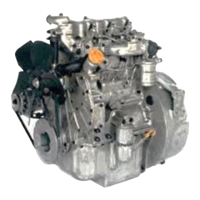
Do you have a question about the Perkins 3.152 Series and is the answer not in the manual?
| Aspiration | Naturally aspirated |
|---|---|
| Fuel System | Direct injection |
| Engine Type | Diesel |
| Governor Type | Mechanical |
| Configuration | 3-cylinder |
| Displacement | 2.5 L (152.7 cu in) |
| Cooling System | Liquid-cooled |
| Weight (Dry) | 295 kg |
| Bore x Stroke | 91.4 mm x 127 mm (3.6 in x 5.0 in) |
Overview of the 3.152 Series engines, their applications, and key features.
List of recommended consumable products for engine maintenance, service, and operation.
Information on available local training programs for engine operation, service, and overhaul.
Identification of engine components shown on the front and left side view.
Identification of engine components shown on the rear and right side view.
Procedure for starting the engine when it is already warm.
Procedure for starting a cold engine without the use of any starting aids.
Procedure for starting a cold engine using the fuelled starting aid system.
Procedure for starting a cold engine using a manually operated start pilot system.
Procedure for starting a cold engine using KBi or electrically operated start pilot.
Instructions for safely stopping the engine, including turbocharger cool-down.
Guidelines on adjusting engine speed settings safely to prevent damage.
Recommendations for running-in new or overhauled engines to ensure optimal performance.
Impact of altitude on engine performance and fuel delivery adjustments.
Defines recommended service intervals for average operating conditions and environmental factors.
Procedure for checking engine drive belt condition and tension.
Procedure for correctly setting engine drive belt tension.
Information on the fuel pre-filter location, draining, and element renewal.
Steps for safely replacing the fuel filter element and eliminating air.
Identifying a defective atomiser by checking its effect on engine speed.
Procedure for replacing a defective fuel atomiser, including torque specifications.
Steps for bleeding air using the standard method on Lucas DPA pumps.
Steps for bleeding air using the self-vent method on DP200/DB2 pumps.
Instructions for draining, cleaning, and refilling a wet type air cleaner.
Guidance on cleaning dust bowls and automatic dust valves in air filters.
Recommended fuel quality and specifications for Perkins engines to ensure optimal performance.
Table listing engine problems and their potential causes for user and workshop checks.
